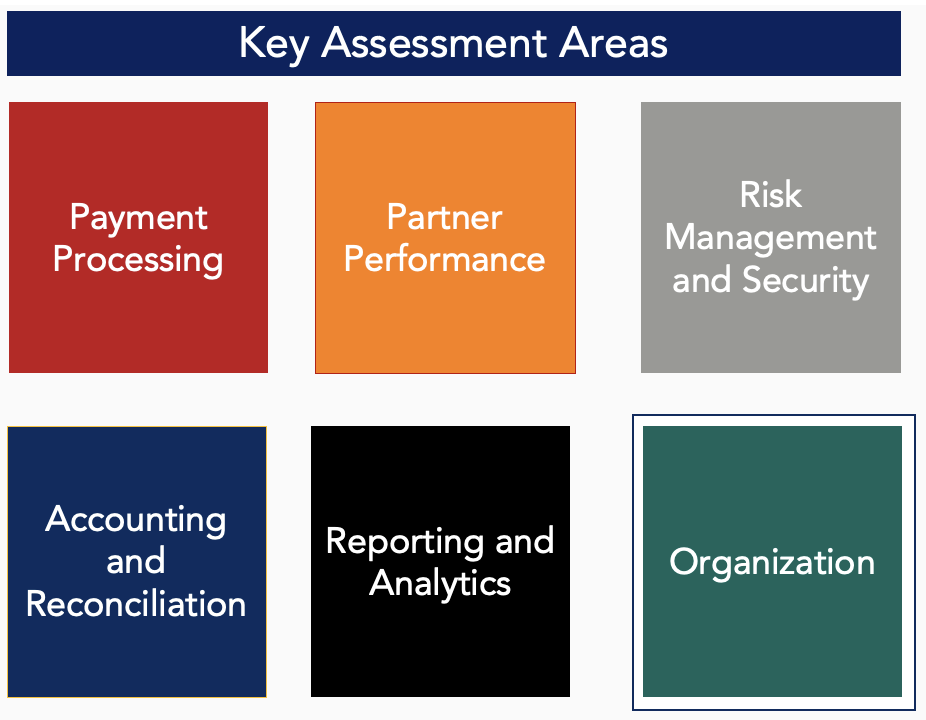In Kavita Jiandani’s post Assessing a Merchant’s Payments Operations, she introduced Glenbrook’s methodology for our in-depth assessment of a merchant’s payments operations. In her introductory piece, Kavita highlights the major Key Assessment Areas we evaluate during each engagement. In this continuation, we examine the impact of the payments organization and the company’s “money team.”
How a merchant manages its payment operations has an outsized influence on profitability as well as customer experience. In this continuation of Glenbrook’s series on Assessing Merchant Payments Operations we look at common organizational structure and contrast that to the best practices we have found most effective in our payments consulting work.

The Typical Situation – Payments in Silos
All too often, the management and organization of payments acceptance within a large merchant organization is owned by individual business lines or channel teams. Management of the e-commerce channel is a prime example. One of Glenbrook’s clients, a grocer, had in-store payment operations owned by a team tightly coupled to its Treasury Management organization while the early stage e-commerce operation was owned by a separate group aligned with Marketing.
This approach is understandable in the rush to bring new and unproven services to market. In the early 2000s, digital transition was in its infancy and the payment volume it represented was, for brick-and-mortar companies, a tiny proportion of overall transaction flow.
That’s all changed. The digital channel continues to experience double digit growth and is accelerated by secular trends such as broad smartphone availability and the current pandemic.
Suboptimal Outcomes
As we have seen through many merchant payments consulting engagements, the siloed model has multiple downsides.
- Poor Choices Lead to High Remediation Costs. We have seen new business lines make uninformed decisions about their payment and data needs that lead to significant levels of re-work and implementation delay. Forethought and planning prior to vendor selection and deployment would have saved money (new contracts, new POS terminals) and time (more than a year of sub-optimal operation).
- Reconciliation Challenges. While many merchants wisely maintain multi-acquirer relationships, uncoordinated payment flows mean that someone in Treasury or Accounting has to reconcile payments processed by different acquirers. We’ve seen painful Excel-based procedures used to handle reconciliation. This is no longer necessary.
- Increased Acceptance Cost. Volume commitments to an acquirer can lower the cost for all business lines. If each business line makes an independent deal, the company as a whole loses potential negotiating leverage based on volume.
- Poor Acceptance Architecture. We’ve seen duplication in payment systems that often comes with increased technical debt and operational management costs that come with redundant maintenance work. Uncoordinated system choices duplicate audit and network update work.
- Poor Customer Experience. There are so many ways to add friction or degrade the experience of making a payment, the list is almost too long. Consider:
- Inability to provide buy-online-pickup-in-store (BOPIS) service
- Requiring a signature when every card brand has made that optional and unnecessary for chargeback purposes
- Leaving contactless support off when the capability has been in the POS terminal for three years and more
- For a Guest checkout, neglecting to take advantage of checkout assistants like SRC or one-click options like PayPal
- At checkout, not displaying the most recently used card on file for returning customers
- Weakened Security and Higher Audit Risk. We have seen rushed implementations and procedures open security holes and increase loss risk and chargeback frequency. Distributed payment responsibilities has resulted in uncoordinated PCI compliance procedures and increased audit expenses.
These downsides can be avoided and remediated. The key is a comprehensive payments strategy for acceptance that centralizes strategic expertise and operational roles.
The Money Team – The Optimal Payments Organization
Centralized management of payments is the essential step in the orchestration of a merchant’s diverse payments needs. This approach works. Leading merchants have recognized that payments is a core competency that has a direct bearing on profitability. Payments processes have multiple constituencies. Centralization of payments roadmap, partner management, operations, and analytics establishes a consistent foundation for this essential function. Centralized responsibility across all payment concerns – from multi-channel acceptance to reconciliation and reporting – drives architectural choices that can best deliver reliability, flexibility, risk management, and cost.
Centralized expertise is best able to meet the needs of all and each of them while optimizing the outcome for the entire company.
The Money Team’s role is to both serve the payments needs of the organization and to drive requirements for payment handling by all business units.
Metrics Matter – A Focus on Data and Analytics
As discussed in our post on Reporting and Analytics, data drives good decision making. The Money Team makes sure the dashboards and underlying systems are in place to monitor and measure KPIs. Some merchants outsource the data warehousing task and bring the dashboards in-house. There is no one right technical solution. But knowing what KPIs matter and having the data infrastructure in place to generate and share them is key.
A key part of Glenbrook’s payments consulting practice is the benchmarking work we conduct to reveal and describe industry best practices. While what works varies by industry and company size, our recommendations on organization are informed by our benchmarking and payments consulting experience with merchants across multiple industries and business sizes.
A Single View on Payment Operations
Payment operations is multi-faceted. Diverse concerns range from transaction speed and authorization optimization to fraud detection and chargeback management. The performance in one area generally impacts adjacent areas in significant ways. Expertise in payments is required to take advantage of positive adjacencies and mitigate the negative ones. Centralization provides operational management the ability to put their expertise to work.
Risk and chargeback management are particular areas that benefit from co-ordinated, if not singular, management.
Vendor Selection and Management
Centralization puts the challenge of partner management into a single group that has the broad view of partner capabilities, synergies, and shortfalls. Selecting the right partner is a multi-step and multi-dimensional process that is merchant-specific. A broader treatment of the incumbent and new vendor review process appeared in our post on Partner Performance.
Expertise and experience is important in vendor selection. For example, service Level Agreements (SLAs) matter. SLAs codify the operational performance expected from a payment partner. Think of them as the KPIs of the partner. Knowing what SLAs to build into a contract matters, too. That said, the financial penalties on the provider don’t come close to compensating the merchant’s pain due to an offline condition, for example. The reliability track record and service resumption speeds is more important than the penalty clause in any SLA.
Staffing
The good news is that the core staffing dedicated to the Money Team can be modest. Only a handful of FTEs is needed to lead the payments strategy, new payment initiatives, manage operations, data analytics, and risk functions.
That said, leadership support (see below) and resource availability, whether under the payment team’s direct control or via matrix-based organization, have to be in place.
Centralized staffing for operational functions, formerly conducted in business line silos, opens up opportunities for staffing development as well as consolidation. Risk and chargeback teams, for example, can enjoy increases in staff expertise through cross-training and exposure to a broader set of operational concerns. Similarly, product, engineering, program management, operations, data scientists, customer experience designers, can all benefit from the Money Team’s coordination role.
Senior Leadership Buy-In
The Money Team approach does not work if its leadership lacks authority and the operational muscle to achieve its goals. Top company leadership has to recognize payments as “mission critical” and strategic instead of a cost to be managed. It has to endorse the model and put into motion the reorganization of functional teams to make the model effective.
For example, Glenbrook has seen a company’s chargeback management processes handled by three different teams with widely different dispute resolution KPIs. Under a single organization, expertise is deepened and KPIs improve.
No Need to Sacrifice Flexibility
Based on Glenbrook’s benchmarking work, we find that many Tier 1 merchants have adopted the “Money Team” model. At some organizations, often those cleaving to the “run fast, break things” entrepreneurial approach, we have encountered resistance to centralization with the complaint “how can a business unit run fast with your bureaucracy?”
The answer is that the Money Team can help the business unit run faster by bringing the team in early, well before vendor selection and any of the technical infrastructure or operation investments are made. With business requirements in hand, the Money Team can advise on who to use and how so that all basic requirements are met while knowing the new solution has the ability to scale should the new initiative prove successful. That, after all, is the point.
How are you organized? Looking for guidance on making changes? We’d love to support your transition to the Money Team. Get in touch if you would like to discuss how your organization could benefit from Glenbrook’s Merchant Payments Assessment.





